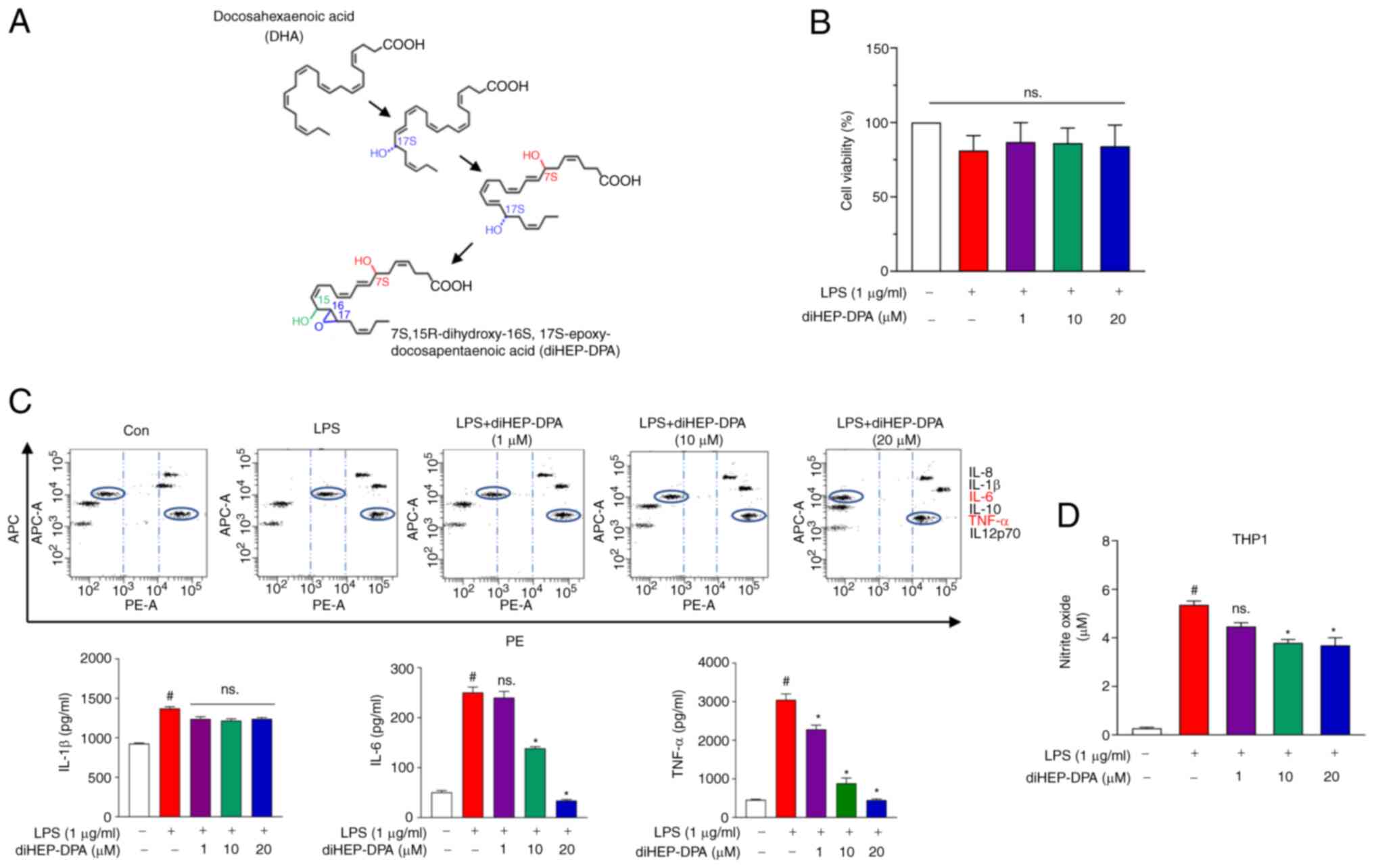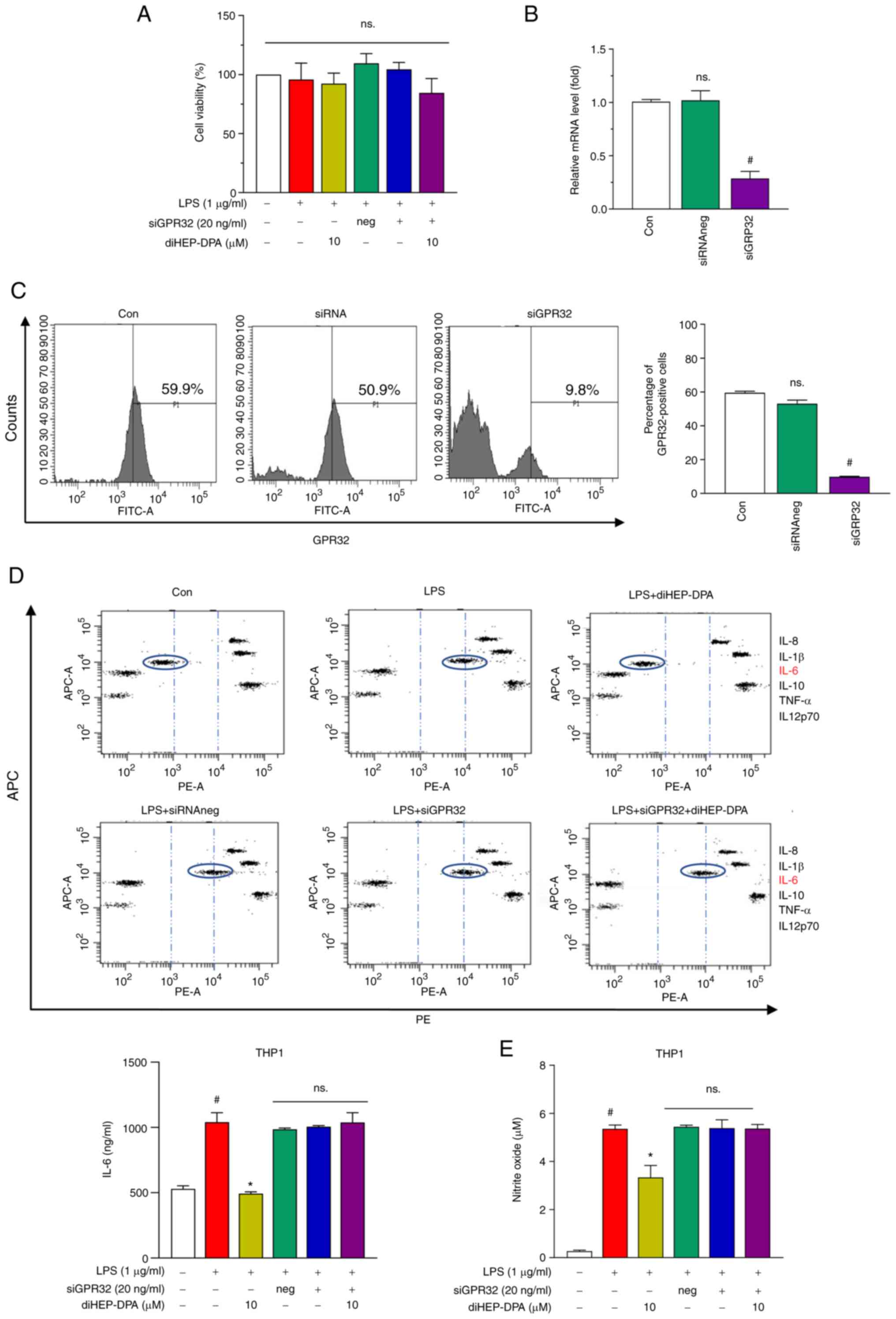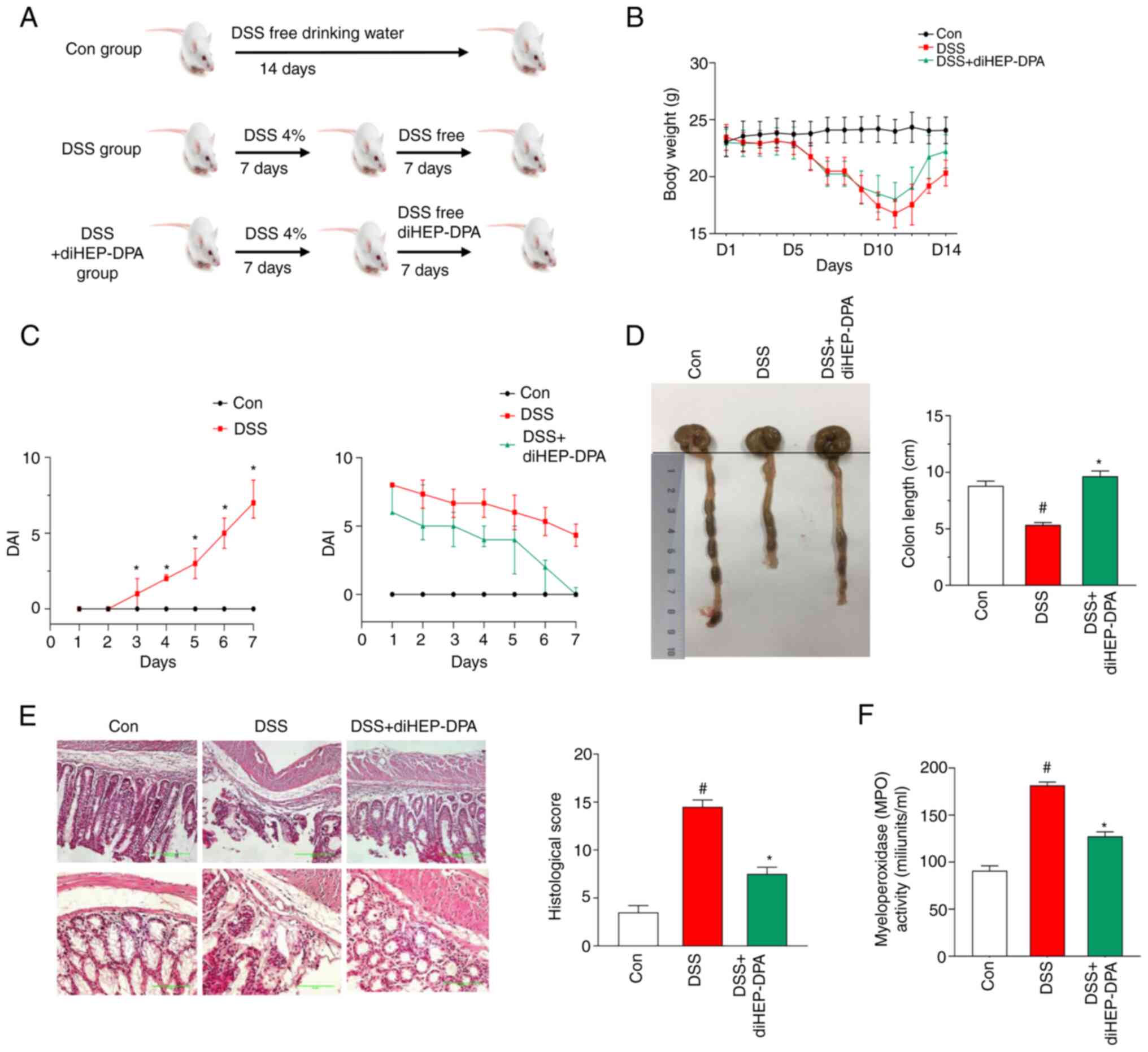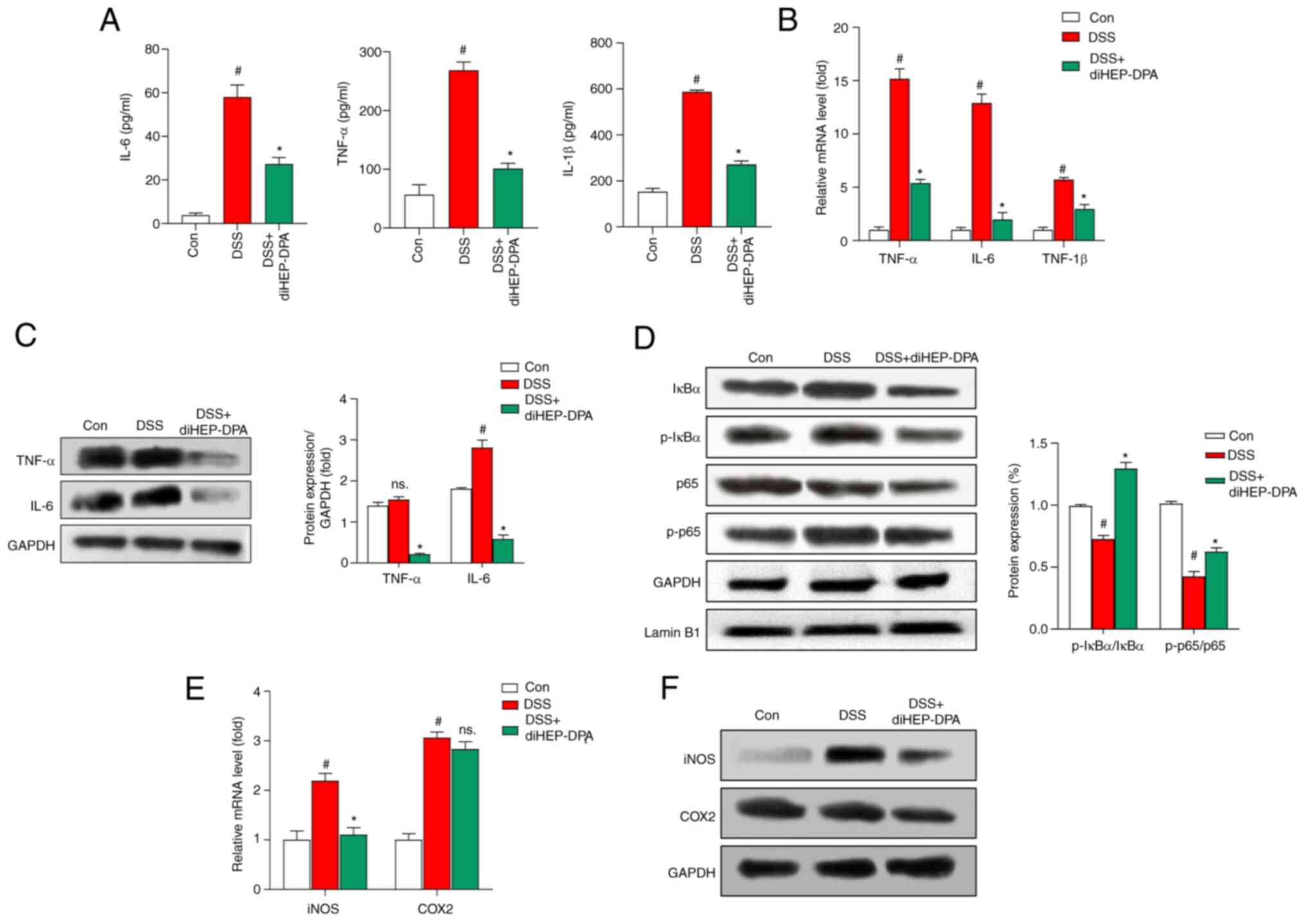Protective effect of 17S‑epoxy‑docosapentaenoic acid against dextran sulfate sodium induced ulcerative colitis in BALB/c mice.
- Authors:
- Published online on: July 15, 2022 https://doi.org/10.3892/mmr.2022.12794
- Article Number: 278
-
Copyright: © Wang et al. This is an open access article distributed under the terms of Creative Commons Attribution License.
Abstract
Introduction
Ulcerative colitis (UC) is an idiopathic relapsing inflammatory illness that leads to long term and occasionally irreversible impairment of gastrointestinal structure and function (1,2). Patients may suffer from abdominal pain and bloody diarrhea as well as rectal excretion of mucus and pus, which markedly affects quality of life (3). Therefore, it is vital to decrease UC and colitis-associated colorectal cancer. UC is induced by genetic risk factors, barrier dysfunction, and environmental and gut microbiota factors (4). Macrophages are widely distributed throughout the gastrointestinal tract. They are found in all mucous membranes and play the most important role in the gastrointestinal immune system (5). Macrophages are activated by pathogen-associated molecular patterns and secrete proinflammatory factors including TNF-α, IL-1, and IL-6, as well as the chemokines CXCL9 and CXCL10 (6). These factors are also involved in the activation of driving UC pathogenesis. There is currently no drug available for the complete cure of UC (7,8).
Specialized pro-resolving mediators (SPMs) are widely regarded as having strong anti-inflammatory activities. Previous studies demonstrated that intraperitoneal treatment with 17-HDHA in a UC mouse model alleviated dextran sulfate sodium (DSS)-induced epithelial damage and macrophage infiltration (9) and Resolvin E1 displayed potent anti-inflammatory effects against colitis and attenuated TNF-stimulated NF-κB activation (10). Resolvin D1 and Resolvin D2 prevented colitis by suppressing the secretion of TNF-α, IL-1β and NF-κB (11). Resonvin D5 could relieve intestinal ischemia reperfusion injury by reducing neutrophil recruitment (12). However, most commercial SPMs exhibit low activity, and the synthesis methods are time-consuming and complicated. To circumvent these problems, we developed an ecofriendly and cost effective method using a microbial enzyme, lipoxygenase derived from Oscillatoria nigroviridis PCC 7112, to generate the compound 7S,15R-dihydroxy-16S,17S-epoxy-Docosapentaenoic Acid (diHEP-DPA) (13).
In the present study, we investigated the effect of diHEP-DPA in a mouse UC model. The results indicate that diHEP-DPA attenuates DSS-induced colitis in vitro and in vivo. The changes in colitis were evaluated by the shortening of colon length, MPO activity, histological damage, etc. Furthermore, diHEP-DPA reduced inflammatory cytokine (IL-1β, IL-6 and TNF-α) expression and NO production by the GPR32 receptor in vitro. These results indicate that diHEP-DPA might improve DSS-induced colitis via the NF-κB signaling pathway.
Materials and methods
Chemicals, kits, and antibodies
diHEP-DPA (purity >98%) was purified and obtained from DHA as described previously (13). Cell activity was assessed using a MTT assay kit (Promega). Lipopolysaccharide (LPS) and Phorbol 12-myristate 13-acetate (PMA) were purchased from Sigma-Aldrich. DSS was obtained from MP biotechnology (Solon, OH, CA). The final DMSO concentration was <0.1% and the control group was treated with DMSO alone. A human monocytic cell line (THP1) was purchased from the Korea Cell Line Bank (Seoul, Republic of Korea).
Cell viability assay
We conducted the MTT assay to determine cell viability. THP1 cells were cultured in RPMI-1640 media containing 10% fetal bovine serum and 1% penicillin/streptomycin and seeded into 96-well plates at a density of 10,000 cells/well. A range of diHEP-DPA concentrations were added with or without LPS (1 µg/ml) for 24 h. After that, MTT solution was added and the optical density (OD490) was determined with a microplate reader (Biotek).
Measurement of proinflammatory cytokines and NO levels
THP1 macrophages were subjected to LPS-induced inflammation according to a previously published protocol (14). Briefly, 100 µl of THP1 cell suspension containing 2×105 cells was seeded into a 96-well-plate. The following day, the cells were treated with LPS (1 µg/ml) with or without diHEP-DPA at various concentrations. After 2 days, the supernatant was collected and centrifuged at 1,000 × g for 5 min. The levels of cytokines were measured using the CBA human inflammatory cytokine assay kit (BD) according to the manufacturer's instructions and the samples were analyzed using a fluorescence-activated cell sorting (FACS) system (BD). The quantification of cytokines was done using the FCAP Array program. The levels of nitrite in the culture medium were determined using the Griess reagent (Promega), according to the manufacturer's instructions.
Small interfering RNA (siRNA) and analysis of FACS
To identify the receptor for diHEP-DPA, we treated the THP1 cell line with human siGPR32 (NM_001506.2; Bioneer), siChemR23 (NM_001142343.1; Bioneer), siFPR2 (NM_001005738.1; Bioneer) or universal negative siRNA (Invitrogen; Thermo Fisher Scientific, Inc.). Briefly, THP1 cells were seeded. GPR32 siRNA was diluted in Opti-MEM Reduced Serum Medium (Thermo Fisher Scientific, Inc.) and added to the culture medium at a final concentration of 20 nM. The transfection of siRNA into THP1-derived macrophages in suspension was done using the TransIT-X2® system kit (Thermo Fisher Scientific, Inc.) according to the manufacturer's instructions. To select the most effective siRNA concentration, real-time quantitative polymerase chain reaction (RT-qPCR) and FACS analysis were performed 48 h after transfection. The samples were incubated with anti-GPR32 antibody (GTX71225; GeneTex) for 30 min on ice. Cells were stained with Alexa Flour 488 goat anti-rabbit antibody (ab15077; Abcam) for 30 min, then analyzed using a FACS system (BD).
Animal experiments
Eighteen six-week-old male BALB/c mice (body weight: 23.26±1.15 g) were purchased from Orien (Seoul, Korea). All mice used in the experiment were housed in an air-conditioned animal room at 24°C±2°C, a relative humidity of 55%, a 12 h light-dark cycle, and were provided tap water and a standard diet. After 7–10 days of acclimation, the mice were used for the experiments. The mice were divided into three groups as follows: normal group (ND, n=6), 4% DSS group (DSS, n=6) and DSS + diHEP-DPA (diHEP-DPA: 20 µg/kg body weight orally through diHEP-DPA, n=6). The body weight of the animals was measured daily. The mice were maintained on 4% DSS for 1 week and treated orally with diHEP-DPA once a day a 1 week. After feeding for 1 week, blood samples were collected by cardiac extraction and serum cytokine levels were measured using a kit (Abcam). The animals were sacrificed by cervical dislocation after used the anaesthesia (isoflurane) and blood collection. For histological analysis, colon tissues were excised, washed rapidly, fixed in neutral-buffered formaldehyde, and stored until used. All animal experiments were performed according to the guidelines for animal handling and welfare at our facilities according to the Institutional Animal Care and Use Committee of the Korea Research Institute of Bioscience & Biotechnology (KRIBB-AEC-20310), Daejeon, Korea.
Evaluation of disease activity index
Animals were daily examined for body weight and disease activity index (DAI). At the end of the intervention (day 14), the DAI was determined by the sum of the following scores: body weight loss (scored as: 0, none; 1, 1–5%; 2, 5–10%; 3, 10–20%; 4, >20%), the presence or absence of fecal blood (scored as 0, negative hemoccult test; 2, positive hemoccult test; 4, gross bleeding), and stool consistency (scored as 0, well-formed pellets; 2, loose stools; 4, diarrhea). The colon tissue was isolated and colon length was measured.
Hematoxylin and eosin (H&E) staining and histopathology of colon tissue
Colon tissues were isolated at the end of culture and the samples were fixed in formalin and embedded in paraffin. Sections of 5 µm thickness were stained with H&E, then evaluated for histological changes by light microscopy and imaging (Leica). The histological scores are shown in Table SI.
Myeloperoxidase (MPO) activity assay
MPO activity can be used to indicate the level of neutrophil infiltration in UC (15). Colon tissues were homogenized in ice-cold HTAB solution and 10-mM EDTA. After centrifuging the homogenate, the supernatant was collected and insoluble material removed. MPO activity was assayed using a myeloperoxidase colorimetric activity assay kit (Sigma-Aldrich, St. Louis, MO, USA) according to the manufacturer's instructions.
Western blot Analysis
Cells were collected and lysed with lysis buffer containing protease and phosphatase inhibitors on ice for 45 min, and centrifuged at 12,000 × g for 5 min. The primary antibodies were all obtained from Abcam and included anti-TNF-α (ab255275), anti-IL-6 (ab233706), anti-IkBα (ab32518), anti-pIkBα (ab133462), anti-p65 (NF-κB) (ab16502), anti-p-p65 (ab76302), anti-iNOS (ab178945), anti-COX2 (ab179800), anti-GAPDH (ab181602), and anti-LaminB1 (ab16048). The membranes were washed three times with TBST, incubated with secondary antibodies (ab205718), and developed using the ECL Plus western blotting detection system (Pierce) according to the manufacturer's protocol. The membranes were exposed to CL-XPosureTM film (Thermo Fisher Scientific, Inc.). The gray density of the scanned images was quantified with Image J software (version 1.6).
Gene expression analysis
Total RNA was isolated using the TaKaRa MiniBEST kit (Takara Bio, Inc.) according to the manufacturer's protocol. RT-PCR was done using 100 ng of total RNA, a reaction volume of 50 µl, and the specific primers listed in Table SII. The PCR cycle conditions were as follows: 95°C for 30 sec, 56°C for 30 sec, and 72°C for 30 sec; 45 cycles, followed by a 10-min extension at 72°C. The relative expression levels were calculated by the comparative CT method. β-actin was used as an internal control.
Statistical analysis
All data are presented as the mean ± standard deviation. Data were analyzed using one-way ANOVA and Tukey's test. Categorical data were analyzed using Mann Whitney U test, or Kruskal-Wallis and Dunn's post hoc test. A P-value less than 0.05 was considered statistically significant. All analyses were performed using GraphPad Prism 8 Software (GraphPad Software Inc.).
Results
Anti-inflammatory effect of diHEP-DPA on LPS-stimulated THP1 cells
Fig. 1A shows the structural change of every intermediate at each step in the synthesis of diHEP-DPA. First, we investigated THP1 macrophage cell viability when treated with or without diHEP-DPA. diHEP-DPA did not cause any cytotoxic effects on THP1 cells as shown in Fig. 1B. The results (Fig. 1C) indicated a significant reduction of IL-6 and TNF-α secretion at 10-µM diHEP-DPA treatment, whereas IL-1β was decreased at 20 µM. Analysis over a range of doses showed that the inhibitory effect of diHEP-DPA was dose-dependent over a concentration range of 1–20 µM. In addition, nitrite levels were measured and the results are shown in Fig. 1D. There was a significant reduction in nitrites compared with the control group.
The anti-inflammatory activity of diHEP-DPA is dependent on the GPR32 receptor
At least six types of resolvins (Resolvin D1 through D6) activate their target cells through GPR32 which led to the renaming of GPR32 to the Resolvin D1 receptor (11,12,16). We determined whether a reduction of GPR32 membrane expression could eliminate the anti-inflammatory effect of diHEP-DPA on LPS-induced inflammation. Fig. 2A shows that negative siRNA or siGPR32 did not alter cell viability. Transient transfection of THP1 with siRNA specific for GPR32 resulted in a significant decrease of GPR32 mRNA and ablated GPR32 expression after 48 h (Fig. 2B and C). Furthermore, we found that the inhibition of diHEP-DPA on inflammatory cytokine secretion and NO production was abolished after transfection with siGPR32 (Fig. 2D and E). Furthermore, we investigated the siChemR23 and siFPR2, both of them which did not abolish the inhibitory effect of diHEP-DPA on inflammatory secretion (Fig. S1). These results indicate that the diHEP-DPA-mediated effects on mouse macrophages are GPR32-dependent and GPR32 may be the receptor, or at least one of the receptors for diHEP-DPA.
The effect of diHEP-DPA on symptoms of DSS-induced colitis in mice
The DSS-induced colitis in vivo experiments were performed according to the experimental design shown in Fig. 3A. After the mice were fed with drinking water (with 4% DSS), we assessed the colitis symptom score (DAI) every day (Fig. 3B). DSS induced a significant weight loss on day 7. After administration of diHEP-DPA, weight recovered gradually and was almost same as the control group at day 7. The results (Fig. 3C) indicated that the DAI score gradually increased from day 3 of DSS induction and was significantly higher compared with the control group from day 4. On day 7, the mice exhibited colitis symptoms meaning that the DSS-induced colitis model was successfully established. After diHEP-DPA administration, the DAI scores of the DSS + diHEP-DPA group remained higher than those of the control group (Fig. 3D). However, compared with the DSS group, diHEP-DPA showed improvement in colitis symptoms on day 4 of diHEP-DPA administration and a significant reduction in the DAI at days 5–7 after diHEP-DPA administration.
diHEP-DPA prevents colonic shortening and pathological damage in DSS-induced colitis
To investigate the effect of diHEP-DPA on colitis, we measured the colon length in vivo. The results (Fig. 3D) show that colon length of the DSS group was shortened, whereas diHEP-DPA attenuated colonic shortening. As shown in Fig. 3E, the colon tissue of DSS-induced mice showed obvious crypt destruction compared with the control group. The histological score of the DSS group was significantly higher than that of the control group and the diHEP-DPA administration group was significantly reduced compared with the DSS group, although it was still higher than the control group. Myeloperoxidase activity (MPO) activity is an indicator of neutrophil infiltration in UC. Fig. 3F shows that MPO activity in the DSS-treated group was significantly increased compared with the control group and following treatment with diHEP-DPA, the MPO activity significantly decreased compared with the DSS-treated group. These results indicate that diHEP-DPA improves DSS-induced UC in vivo.
diHEP-DPA attenuates the level of inflammatory factors in serum and colon tissue
We further characterize the inflammation by detecting the expression of cytokines in the serum, including TNF-α, IL-6, and IL-1β. The results showed that diHEP-DPA suppressed the production of inflammatory cytokines as shown in Fig. 4A. We also measured the expression of these inflammatory factors in colon tissue at the mRNA and protein level (Fig. 4B and C) and the results indicated that diHEP-DPA significantly attenuated DSS-induced inflammatory factor (TNF-α and IL-6) expression. As shown in Fig. 4D, colon tissue from DSS-induced mice had significantly increased levels of p-p65 and p-IκBα protein in the nucleus compared with the control group. DiHEP-DPA-treated mice exhibited decreased accumulation of nuclear p65 compared with DSS-induced mice. DiHEP-DPA did not have a significant effect on IκBα expression in the cytosol, whereas it decreased p65 levels compared with the DSS-treated group. As shown in Fig. 4E and F, the expression of iNOS was significantly higher in the DSS-treated group than in the control group and diHEP-DPA significantly reversed this effect. COX2 showed no significant changes following DSS treatment, whereas decreased COX2 expression was observed in the diHEP-DPA-treated group.
Discussion
DSS-induced colitis is a pathological syndrome similar to human UC and is associated with body weight loss, diarrhea, blood in the stool, and inflammatory cell infiltration; thus, it is a widely used in vivo model for UC (17). We have developed a novel SPM, diHEP-DPA, which was synthesized in our previous work by a biosynthetic method (Fig. 1A). The product displayed anti-inflammatory activity in LPS-induced human macrophage cells and in a DSS-induced UC mouse model. The results showed that diHEP-DPA attenuates LPS-induced inflammatory cytokines (TNF-α, IL-6, IL-1β) and NO production by GPR32 in human macrophages and alleviates the inflammation in DSS-induced colitis in mice. Furthermore, the underlying mechanism may also involve the inhibition of NF-κB signaling.
We demonstrated the anti-inflammatory activity of diHEP-DPA in an LPS-induced THP1 macrophage inflammation model. Treatment with diHEP-DPA did not reduce the viability of THP1 macrophages even at high concentrations (Fig. 1B), whereas the levels of TNF-α, IL-6, and IL-1β were markedly reduced under in vitro and in vivo conditions (Figs. 1C, 4E, and C). A beneficial effect of NO derived from constitutive NOS and a detrimental effect of NO produced by inducible NOS (iNOS) may be observed during the development of colitis (18). Therefore, we investigated the effect of diHEP-DPA on NO production and the results showed that diHEP-DPA decreased NO production in vitro (Fig. 1D) and inhibited the expression of iNOS protein in vivo (Fig. 4F). GPR32 is an important receptor in mediating the effects of resolvin in human macrophages (19). To identify the receptor of diHEP-DPA, we treated THP1 macrophages with siGPR32, siFPR2, and siChemR23. The results (Figs. 2 and S1) indicated that siGPR32 silenced the expression of GPR32 markedly and the positive effect of diHEP-DPA on LPS-induced inflammation was eliminated in siGPR32-treated THP1 macrophages. Thus we suspected that GPR32 might be one of the receptor for diHEP-DPA. For more solid evidence, we will confirm the binding of GPR32 and diHEP-DPA in further study.
We also observed that the diHEP-DPA-treated group showed improved conditions than the DSS-treated group, such as reduced body weight loss, retained colon length, and reduced DAI score as shown in Fig. 3. Moreover, diHEP-DPA prevented any macroscopic damage to the colon tissue by reducing the accumulation of neutrophils (Fig. 3F). Additionally, diHEP-DPA reduced the secretion and expression of inflammatory cytokines. Increased secretion of inflammatory cytokines causes severe colitis hallmarked by active NF-κB signaling (20). Our findings indicate that the novel SPM, diHEP-DPA, also has the ability to ameliorate DSS-induced colitis by upregulating antioxidant defenses by suppressing NF-κB activation. The expression levels of iNOS and p-IκBα proteins were significantly increased in colitis-induced mice. Reports suggest that the production of proinflammatory cytokines could cause the disruption of tight junctions and intestinal homeostasis in colitis (21), and that there is a strong association between iNOS-induced proinflammatory cytokines and the condition of mucosal inflammation in UC pathogenesis. Therefore, diHEP-DPA inhibits NF-κB activation in UC mice by reducing the expression of proinflammatory cytokines and inhibiting NF-κB translocation by disrupting the phosphorylation and degradation of IkB-α (Fig. 4). In summary, oral administration of diHEP-DPA effectively suppressed the pathogenesis of UC in a mouse model. These results suggest a role for the dietary component, diHEP-DPA, as an anti-inflammatory agent for UC prevention and treatment.
In conclusion, diHEP-DPA is a novel SPM which was previously synthesized by our group. In the present study, we explored its potential application in UC treatment. The results indicated that diHEP-DPA effectively reduces inflammatory cytokine secretion in vitro and attenuates the DSS damage to the colon in vivo. Mechanistically, diHEP-DPA inhibits the activation of the NF-κB signaling pathway.
Supplementary Material
Supporting Data
Supporting Data
Acknowledgements
Not applicable.
Funding
The present research was funded by the Ministry of Oceans and Fisheries, Korea (grant no. 20210285) and the KRIBB Research Initiative Program (grant no. KGM5482113).
Availability of data and materials
The datasets used and/or analyzed during the current study are available from the corresponding author on reasonable request.
Authors' contributions
LW performed all the experiments and wrote the manuscript. HC helped design all the experiments and supervised the preparation of the manuscript. YS helped with animal experiments and some western blotting experiments. BL, SHJ and JC helped by providing the fluorescence microscope, FACS protocol, they also helped perform the related experiments and analyzed the data. YJ and JS supervised the study, reviewed the manuscript, and provided the funding and conception of this study. All authors have read and approved the final version of the manuscript. LW, YJ and JS confirmed the authenticity of all the raw data.
Ethics approval and consent to participate
All animal experiments were approved bythe Institutional Animal Care and Use Committee of the Korea Research Institute of Bioscience and Biotechnology (approval no. KRIBB-AEC-20310; Jeongup, Republic of Korea).
Patient consent for publication
Not applicable.
Competing interests
The authors declare that they have no competing interests.
References
|
Baumgart DC and Carding SR: Inflammatory bowel disease: Cause and immunobiology. Lancet. 369:1627–1640. 2007. View Article : Google Scholar | |
|
Bouma G and Strober W: The immunological and genetic basis of inflammatory bowel disease. Nat Rev Immunol. 3:521–533. 2003. View Article : Google Scholar | |
|
Greuter T and Vavricka SR: Extraintestinal manifestations in inflammatory bowel disease-epidemiology, genetics, and pathogenesis. Expert Rev Gastroenterol Hepatol. 13:307–317. 2019. View Article : Google Scholar | |
|
Bonen DK and Cho JH: The genetics of inflammatory bowel disease. Gastroenterology. 124:521–536. 2003. View Article : Google Scholar : PubMed/NCBI | |
|
Flannigan KL, Geem D, Harusato A and Denning TL: Intestinal antigen-presenting cells: Key regulators of immune homeostasis and inflammation. Am J Pathol. 185:1809–1819. 2015. View Article : Google Scholar | |
|
Kmieć Z, Cyman M and Ślebioda TJ: Cells of the innate and adaptive immunity and their interactions in inflammatory bowel disease. Adv Med Sci. 62:1–16. 2017. View Article : Google Scholar | |
|
Spencer EA and Dubinsky MC: Therapeutic drug monitoring in inflammatory bowel disease: History and future directions. Pediatr Clin North Am. 64:1309–1326. 2017. View Article : Google Scholar : PubMed/NCBI | |
|
Dulai PS and Jairath V: Acute severe ulcerative colitis: Latest evidence and therapeutic implications. Ther Adv Chronic Dis. 9:65–72. 2018. View Article : Google Scholar : PubMed/NCBI | |
|
Chiu CY, Gomolka B, Dierkes C, Huang NR, Schroeder M, Purschke M, Manstein D, Dangi B and Weylandt KH: Omega-6 docosapentaenoic acid-derived resolvins and 17-hydroxydocosahexaenoic acid modulate macrophage function and alleviate experimental colitis. Inflamm Res. 61:967–976. 2012. View Article : Google Scholar : PubMed/NCBI | |
|
Arita M, Bianchini F, Aliberti J, Sher A, Chiang N, Hong S, Yang R, Petasis NA and Serhan CN: Stereochemical assignment, antiinflammatory properties, and receptor for the omega-3 lipid mediator resolvin E1. J Exp Med. 201:713–722. 2005. View Article : Google Scholar : PubMed/NCBI | |
|
Bento AF, Claudino RF, Dutra RC, Marcon R and Calixto JB: Omega-3 fatty acid-derived mediators 17(R)-hydroxy docosahexaenoic acid, aspirin-triggered resolvin D1 and resolvin D2 prevent experimental colitis in mice. J Immunol. 187:1957–1969. 2011. View Article : Google Scholar | |
|
Gobbetti T, Dalli J, Colas RA, Federici Canova DF, Aursnes M, Bonnet D, Alric L, Vergnolle N, Deraison C, Hansen TV, et al: Protectin D1n-3 DPA and resolvin D5n-3 DPA are effectors of intestinal protection. Proc Natl Acad Sci USA. 114:3963–3968. 2017. View Article : Google Scholar : PubMed/NCBI | |
|
Yi JJ, Heo SY, Ju JH, Oh BR, Son WS and Seo JW: Synthesis of two new lipid mediators from docosahexaenoic acid by combinatorial catalysis involving enzymatic and chemical reaction. Sci Rep. 10:188492020. View Article : Google Scholar : PubMed/NCBI | |
|
Wang L, Choi HS, Su Y, Lee B, Song JJ, Jang YS and Seo JW: 7S,15R-Dihydroxy-16S,17S-Epoxy-Docosapentaenoic Acid, a Novel DHA Epoxy Derivative, Inhibits Colorectal Cancer Stemness through Repolarization of Tumor-Associated Macrophage Functions and the ROS/STAT3 Signaling Pathway. Antioxidants (Basel). 10:14592021. View Article : Google Scholar : PubMed/NCBI | |
|
Serhan CN, Chiang N, Dalli J and Levy BD: Lipid mediators in the resolution of inflammation. Cold Spring Harb Perspect Biol. 7:a0163112014. View Article : Google Scholar | |
|
Spite M, Norling LV, Summers L, Yang R, Cooper D, Petasis NA, Flower RJ, Perretti M and Serhan CN: Resolvin D2 is a potent regulator of leukocytes and controls microbial sepsis. Nature. 461:1287–1291. 2009. View Article : Google Scholar : PubMed/NCBI | |
|
Wirtz S, Neufert C, Weigmann B and Neurath MF: Chemically induced mouse models of intestinal inflammation. Nat Protoc. 2:541–546. 2007. View Article : Google Scholar | |
|
Rumi G, Tsubouchi R, Okayama M, Kato S, Mózsik G and Takeuchi K: Protective effect of lactulose on dextran sulfate sodium-induced colonic inflammation in rats. Dig Dis Sci. 49:1466–1472. 2004. View Article : Google Scholar | |
|
Schmid M, Gemperle C, Rimann N and Hersberger M: Resolvin D1 polarizes primary human macrophages toward a proresolution phenotype through GPR32. J Immunol. 196:3429–3437. 2016. View Article : Google Scholar | |
|
Seong MA, Woo JK, Kang JH, Jang YS, Choi S, Jang YS, Lee TH, Jung KH, Kang DK, Hurh BS, et al: Oral administration of fermented wild ginseng ameliorates DSS-induced acute colitis by inhibiting NF-κB signaling and protects intestinal epithelial barrier. BMB Rep. 48:419–425. 2015. View Article : Google Scholar : PubMed/NCBI | |
|
Peterson LW and Artis D: Intestinal epithelial cells: Regulators of barrier function and immune homeostasis. Nat Rev Immunol. 14:141–153. 2014. View Article : Google Scholar |













